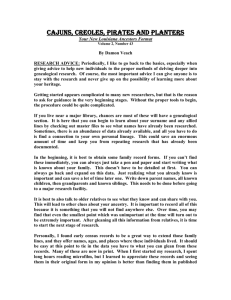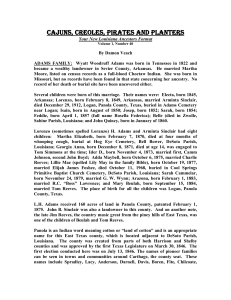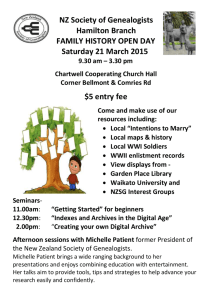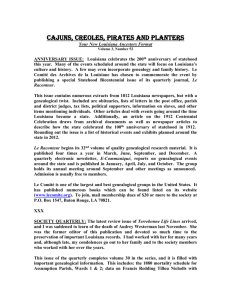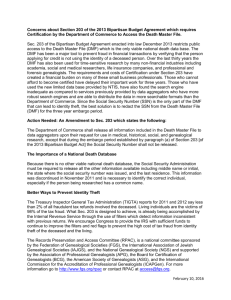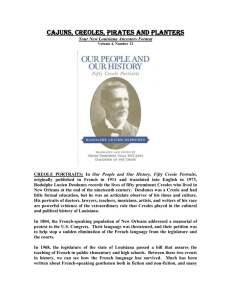cajunsv1n29 - Claitor`s Law Books and Publishing Division
advertisement
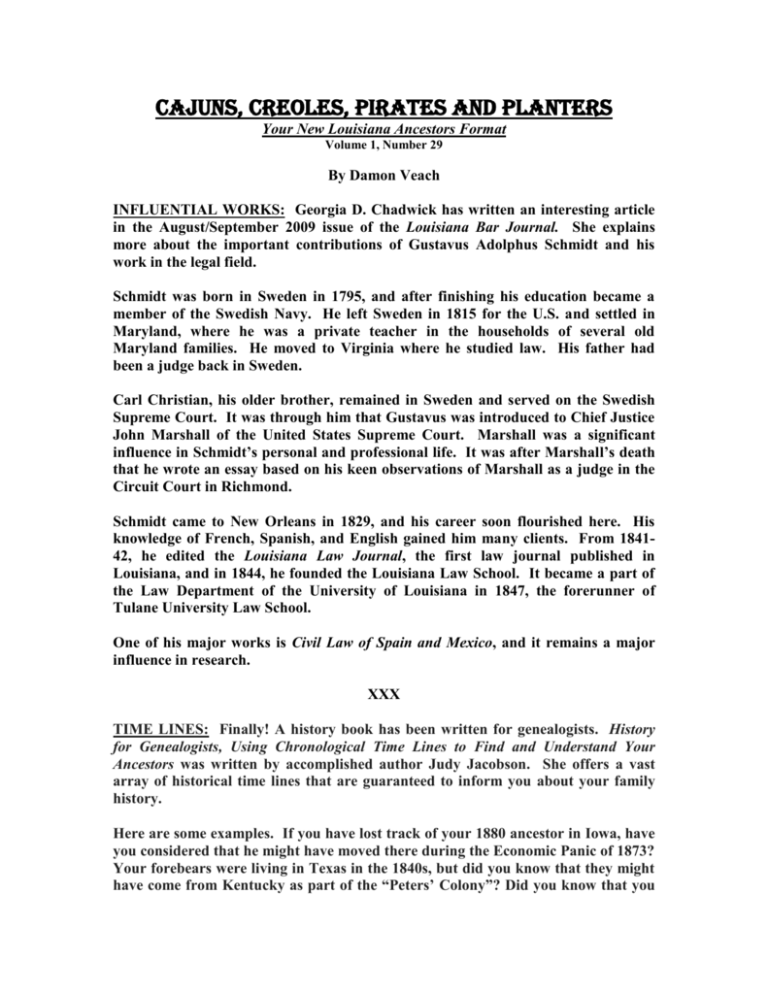
CAJUNS, CREOLES, PIRATES AND PLANTERS Your New Louisiana Ancestors Format Volume 1, Number 29 By Damon Veach INFLUENTIAL WORKS: Georgia D. Chadwick has written an interesting article in the August/September 2009 issue of the Louisiana Bar Journal. She explains more about the important contributions of Gustavus Adolphus Schmidt and his work in the legal field. Schmidt was born in Sweden in 1795, and after finishing his education became a member of the Swedish Navy. He left Sweden in 1815 for the U.S. and settled in Maryland, where he was a private teacher in the households of several old Maryland families. He moved to Virginia where he studied law. His father had been a judge back in Sweden. Carl Christian, his older brother, remained in Sweden and served on the Swedish Supreme Court. It was through him that Gustavus was introduced to Chief Justice John Marshall of the United States Supreme Court. Marshall was a significant influence in Schmidt’s personal and professional life. It was after Marshall’s death that he wrote an essay based on his keen observations of Marshall as a judge in the Circuit Court in Richmond. Schmidt came to New Orleans in 1829, and his career soon flourished here. His knowledge of French, Spanish, and English gained him many clients. From 184142, he edited the Louisiana Law Journal, the first law journal published in Louisiana, and in 1844, he founded the Louisiana Law School. It became a part of the Law Department of the University of Louisiana in 1847, the forerunner of Tulane University Law School. One of his major works is Civil Law of Spain and Mexico, and it remains a major influence in research. XXX TIME LINES: Finally! A history book has been written for genealogists. History for Genealogists, Using Chronological Time Lines to Find and Understand Your Ancestors was written by accomplished author Judy Jacobson. She offers a vast array of historical time lines that are guaranteed to inform you about your family history. Here are some examples. If you have lost track of your 1880 ancestor in Iowa, have you considered that he might have moved there during the Economic Panic of 1873? Your forebears were living in Texas in the 1840s, but did you know that they might have come from Kentucky as part of the “Peters’ Colony”? Did you know that you can learn a great deal about your ancestors if they belonged to a labor or fraternal organization like the Amalgamated Clothing Workers, Brotherhood of Locomotive Engineers, or the Catholic Family Life Insurance Society? As Jacobson explains it - “The average person might define historical research as the study of the human past and genealogical research as the study of a human’s past. History lays the foundation to understand a group of people. Genealogy lays the foundation to understand a person or family using tangible evidence. Yet history also lays the foundation to understand why individuals and societies behave the way they do. It provides the building materials needed to understand the human condition and provide an identity, be it for an individual or a group or an institution.” The initial chapters of History for Genealogists explain the value of historical time lines. Here the reader learns the clues that time lines can suggest about hidden aspects of our ancestors’ lives. Jacobson illustrates the virtues of time lines with several case studies. The bulk of her latest volume consists of specific historical time lines that answer fundamental questions about our forebears. For example, if you are trying to learn when your ancestors left one place for another, it would be helpful to ask the question, “Why did they leave?” Did it have to do with a military conflict, social injustice, religion, disease, economic hardship, a natural disaster? No matter what the explanation, Jacobson has a historical time line that could lead to the explanation. For example, your ancestor’s departure may have coincided with the outbreak of the Crimean War, a virulent epidemic, an earthquake, or a religious war. Other chapters pose answers to other crucial questions, such as “How did they go?” and “What route did they take?” For these conundrums, Jacobson uses time lines to lay out the history of the transportation revolutions in America (roads, rails, canals, and air travel), as well as the history of the great western trails our ancestors followed in crossing the country. Jacobson dissects the past into scores of time lines. There is a time line of the Industrial Revolution, American immigration, and the Labor Movement. Researchers can also make use of a time line for the history of each of the 50 states, and, in brief, for the rest of North America, Europe, and more. History for Genealogists concludes with a helpful bibliography and an index of people and places, wars and battles. It is the one history book all genealogists should own when they are searching for fresh clues or hoping to understand what made their ancestors tick. The price of this book is $34.95, postpaid, and it can be ordered directly from Clearfield Company, 3600 Clipper Mill Road, Suite 260, Baltimore, MD 21211-1953. xxx IRISH GROUP: Another recent book from Genealogical Publishing Company (same address as Clearfield Company) is Erin’s Sons: Irish Arrivals in Atlantic Canada, 1751-1858 (Volume III). Approximately 7,000 additional Irish-born residents of Atlantic Canada are listed in this excellent book. Like the other volumes, it is based on a wide variety of genealogical sources, including church records, cemetery inscriptions, marriage and burial records, newspapers, census records, and ship’s passenger lists. It is priced at $35.00, postpaid. Scattered throughout the volume there are out-of-the-way records pertaining to rescued and quarantined passengers, deserters, and runaways, and equally obscure records of individuals who suffered from anti-Irish prejudice during the 1840s. Many entries date from the 1850s, with earlier years showing up in land records, passenger lists, and military records. The largest groups of records included here are based on newspaper notices of marriages and deaths, regimental records, and land records. The single largest collection is the newspaper notices of marriages and deaths, 1854-1858, extracted from newspapers published in Nova Scotia, New Brunswick, and Newfoundland. This also includes the greatest amount of genealogical detail – place and date of birth and death, date of emigration from Ireland, date of marriage, and names of family members. The regimental records, in particular the 97th Regiment, 1827-1853, show the dispersal of the soldiers at the end of their service and include date and place of birth, with date, place, and reason for discharge. The land records, including some 900 petitions for grants of land in Nova Scotia, give the name of the petitioner, the date of the petition, sometimes the place of origin in Ireland, and the area in Nova Scotia. Also included in this book are maps showing the areas of peak migration from Ireland to Atlantic Canada, an index of surnames, and an index of ships. It is a very good compilation and one that should be in all major genealogical library collections. XXX CANARY ISLANDERS: The September 12th meeting of the Canary Islanders Heritage Society held at the Louisiana State Archives featured a presentation by Dessiree Aguado highlighting her home island of Tenerife. Aguado, a Spanish teacher in Lafayette, discussed the customs, heritage, architecture, agriculture, and ecology of this largest of the Canary Islands. Pictured above, from left to right are: Sergio Ramos (Treasurer), Antonio Matarredona (Education Advisor, Spanish Resource Center), Dessiree Aguado (Guest Speaker), Rose Marie Powell (President) and Kathy Brumfield (Member). XXX COLUMN INFORMATION: Submittals for consideration and inclusion in this column format should be sent to Damon Veach, 709 Bungalow Lane, Baton Rouge, LA 70802-5337 or by e-mail to ancestorslaveach@cox.net. Books review copies, queries, and society notices are used in this format as space permits.
